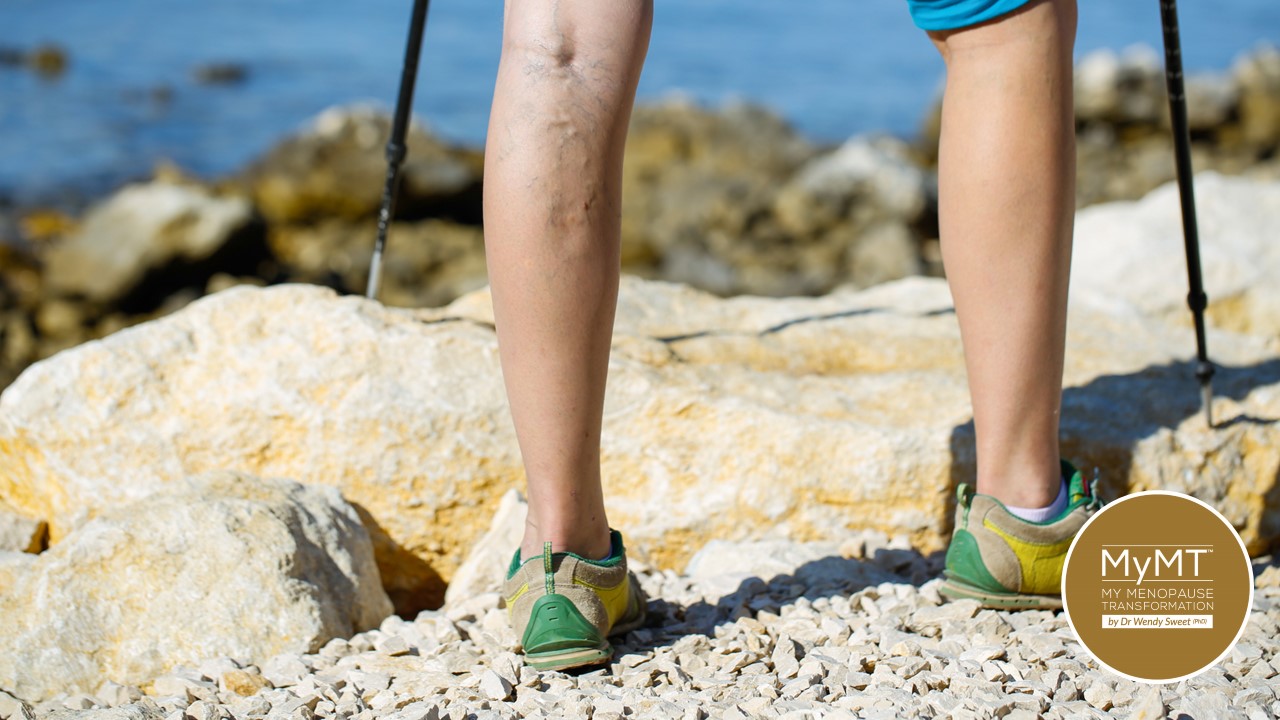Are you in menopause or perimenopause? Do you have varicose or spider veins? Understand the link between menopause and varicose veins.
She was off to get her veins stripped. “I’m doing weight-training workouts and my legs always feel heavy and sore afterwards. This goes on for a few days, but they also ache and get restless at night,” she mentioned to me.
I knew she loved her exercise and had done so for decades, so I raised my eyebrows and said, “I hope that you aren’t doing heavy power-lifting and holding your breath during the lift, as this can increase your blood pressure and change your vascular health now that you’re in menopause and your hormone levels are changing. The additional load might even make your varicose veins worse.” Her reaction confirmed to me that she had no idea what I was talking about.
In exercise physiology the additional pressure exerted through lifting heavy weights and holding one’s breath, is known as the Valsalva Manoeuvre – and as we move through menopause, this can change our vein health. It doesn’t have to be weights either – some of you are in physical jobs whereby you are lifting heavy loads too. Some of the nurses who join me on the MyMT™ programmes, know about this heavy, physical work which contributes to changing vascular health as they age.
Holding your breath as you lift heavy weights, may contribute to greater pressure on your cardiovascular system. This is because the breath-holding increases your intra-thoracic (chest) pressure.
For some women, especially those who are carrying extra weight around their diaphragm and belly, this known phenomenon may contribute to changes to the blood vessels, which are already undergoing changes due to the hormonal changes during menopause.
If you have ever held your breath to lift a heavy object, put it down and felt faint and dizzy, then that’s the effect of the Valsalva Manoeuvre.
Whether you are an experienced weight-lifter, or you lift heavy loads during your normal working day, then hopefully you are getting your blood pressure checked regularly – especially if you already have varicose veins or spider veins.
For those of you with existing vascular or blood vessel inflammation and changing vein health, or for women who have naturally high estrogen levels and are carrying excess weight, especially around the abdominal region, then frequent heavy weight-lifting (more than twice weekly) may actually increase your blood pressure at a time of your life, when your blood vessels are losing some elasticity due to declining levels of estrogen.
This may then place women at greater risk of having higher blood pressure with age (Nascimento, da Silva et al, 2018) … or needing your varicose veins seen to by a vascular surgeon.
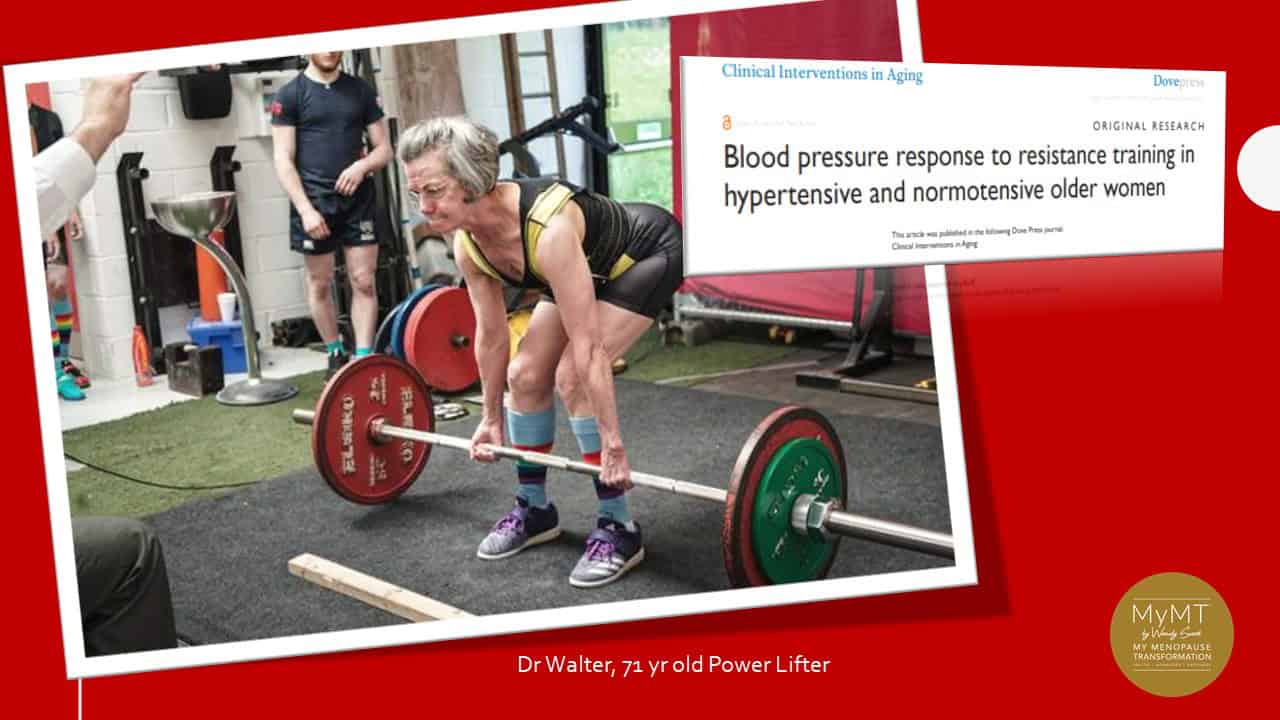
The Connection between Estrogen Levels and Varicose Veins:
One of the most frequent problems affecting women as they age and impacting their tolerance to exercise, especially high impact exercise, isn’t only their changing joint health. It’s also their aching lower legs and changes to the venous system (veins) in the lower limbs.
If you’ve been kicking your feet out of the bedding at night and you’ve had hot feet or you find that your legs are aching for longer after exercise, then you will know what I’m talking about. During menopause, it’s known as ‘restless leg syndrome.’
That’s why I was pleased to find that researchers in Italy (Ciardullo, Panico, Bellati et al, 2000) have found a curious connection between higher oestrogen levels in menopausal and post-menopausal women and the incidence of varicose veins.
While this sounds confusing because levels of estrogen decline as we move through menopause, if you are someone who is oestrogen dominant (and puts on body-fat easily or you are already carrying excess weight), then you may have higher oestrogen levels, even during menopause.
This is all to do with the fact that fat cells, especially deep, visceral fat cells, love storing oestrogen.
Fat cells love to store excess oestrogen. Excess oestrogen may be taken into our body via a range of factors, including certain food (saturated fats), plastics, medications and environmental chemicals. Alcohol also esterifies (breaks down) into a form of oestrogen. Hence, many of these excess oestrogen compounds are carried into fat cells, which are also hormonally active, and produce their own form of oestradiol. With these excess fat storage levels, some of you who are struggling with excess weight gain, may indeed have higher levels of oestrogen stored in your body – even in post-menopause.
When oestrogen levels are higher in the body, this can affect a woman’s vascular health. Varicose veins are veins that are inflamed and have valves that don’t close properly. They may appear as enlarged veins, twisted veins or purple veins. Typically, vein screening is used to diagnose them by measuring blood flow and vein health.
If you are troubled by your veins, this is often due to the disruption to fluid shifts in and out of the tissues. If you have swollen ankles or your legs are aching after impact-exercise, then these fluid shifts may cause some blood to pool in the veins, especially in lower-leg veins.
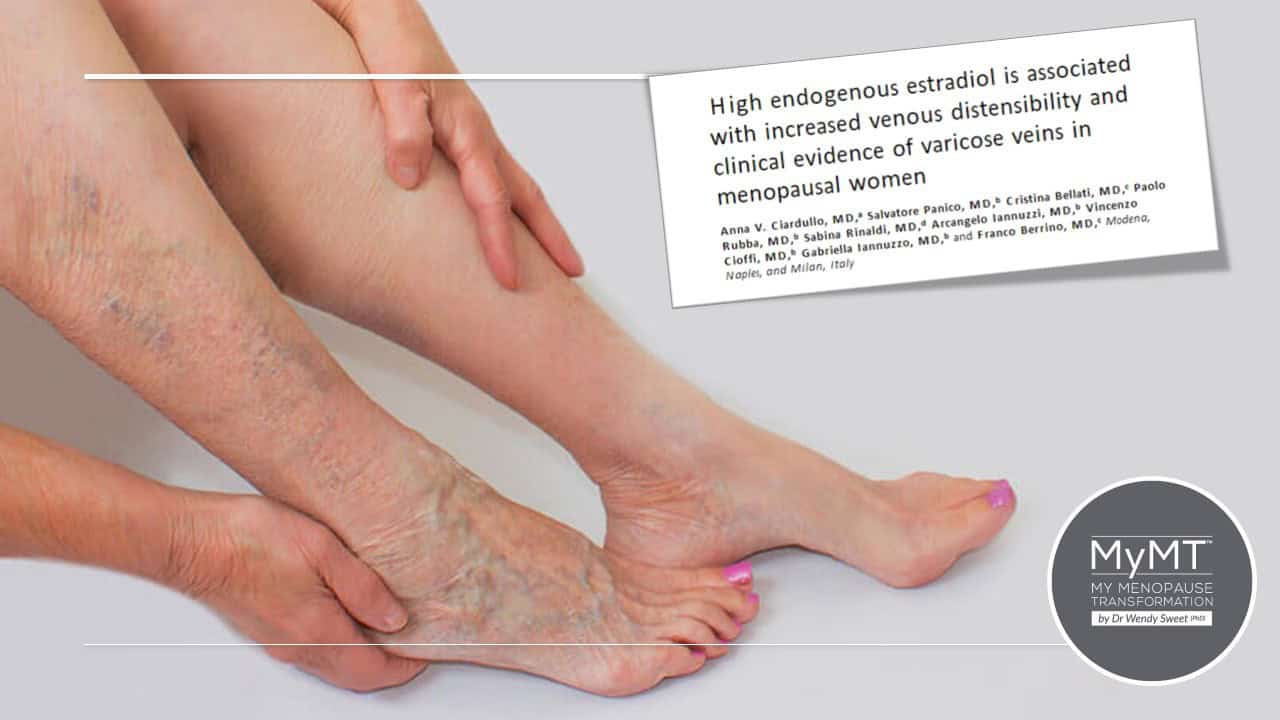
Varicose veins are veins that are inflamed and have valves that don’t close properly.
We all know the unsightliness of engorged and swollen veins. My mother was troubled by these too, and some of you may have experienced these changes in pregnancy as well. This is because oestrogen and progesterone are involved in fluid shifts in and out of tissues and in veins. In fact, the decline in progesterone during the menopause transition can cause disruption to the constriction of blood vessels too.
I’m now a lot more cautious about high-intensity impact exercise as well as heavy weight training, my intake of excess oestrogens (read more HERE) and looking after my blood pressure as I get older. I better understand the effect of excess circulating oestrogens on our vein health.
As Ciardullo et al, (2000) mention:
‘Our findings are that high serum levels of estradiol (also spelled oestradiol) are associated with clinical evidence of varicose veins. Our measurements suggest that increased venous distension in menopausal women may be impacted by endogenous oestrogens and that these may play a role in the development of these very common venous vessel abnormalities.”
Oestradiol is an oestrogen steroid hormone and as we all know, it is the major female steroid hormone that is involved in the regulation of our hormonal cycle.
In menopause, the amount of oestradiol declines, but unbeknownst to many women, it is always present, even in post-menopause. And some women produce more oestradiol naturally than others. It’s genetic.
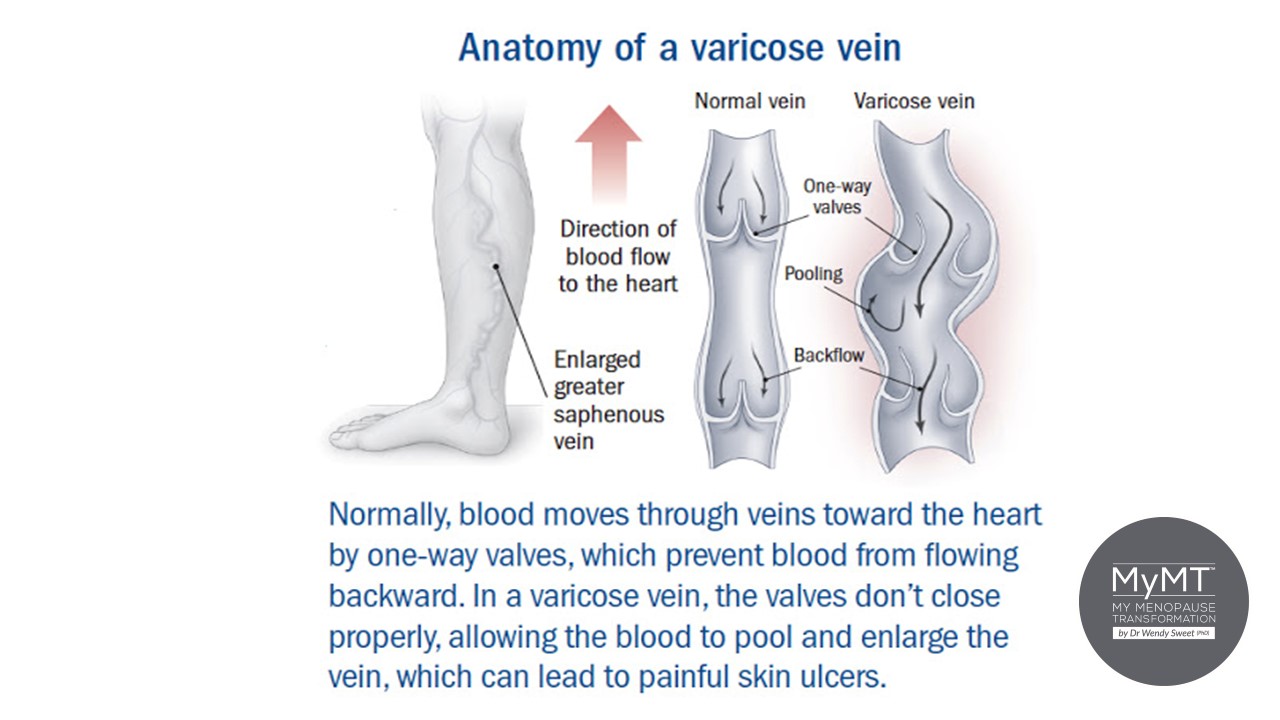
Reduce the Effect of Varicose Veins
To keep your veins healthy, you should naturally seek the recommendations of a vein specialist where you’ll likely be referred for vein screenings. But if you want to reduce varicose vein symptoms then the following lifestyle solutions may also benefit you.
(1) Change your diet. Don’t get fooled by diets that aren’t designed with our ageing blood vessels in mind. All of the women who come into the 12 week MyMT™ programmes learn how important it is to follow a Mediterranean influenced, anti-inflammatory diet which is evidenced for helping our heart health – and yes, grains are important too.
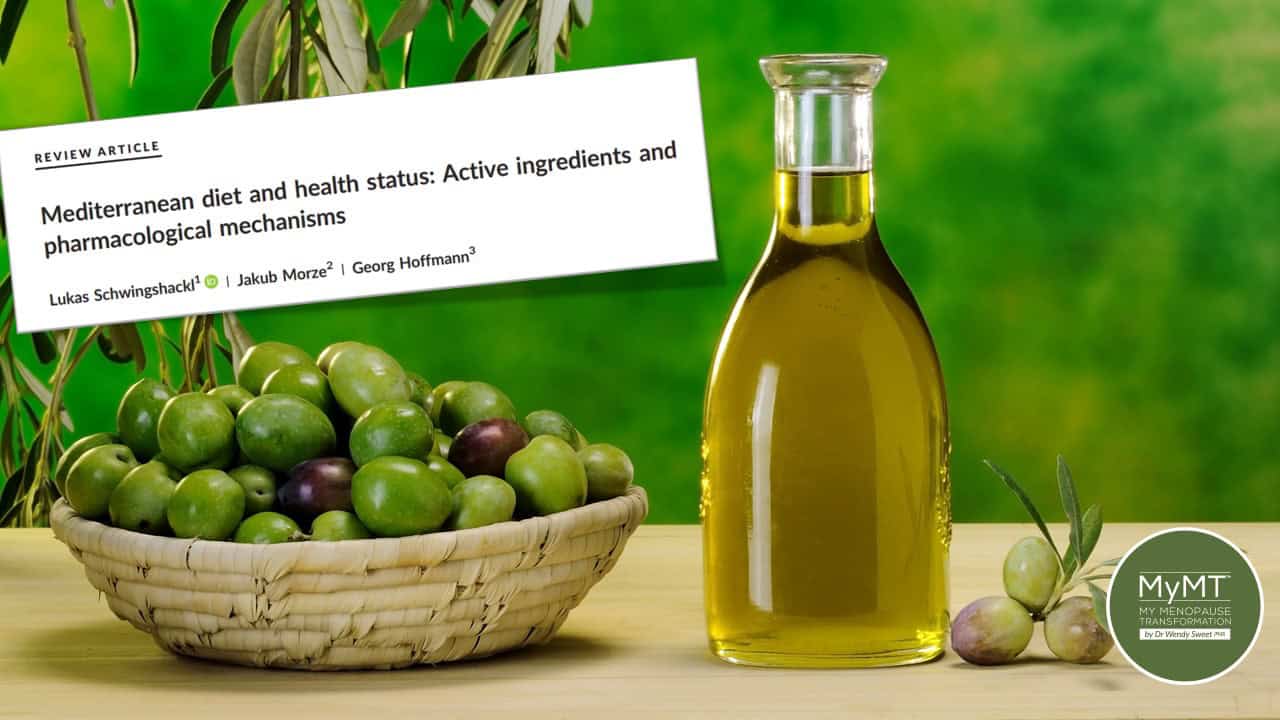
2) Add beetroot/beets to your diet. There is always a flurry of activity in my coaching groups when someone announces that they have added some beetroot juice to their diet.
I recommend it to them all (unless they have low BP) and I especially mention it to women who are undertaking moderate exercise and/or training daily and those with vascular problems.
Beetroot (or Beet) has compounds (nitrates) which help blood vessels to dilate. Dietary inorganic nitrate from vegetables such as beetroot is absorbed rapidly and completely in the small intestine with 100% bioavailability.
Numerous women get put on anti-hypertensives in mid-life, but I wonder how many know to have their beetroot as well? It’s not just beetroot that’s important either – there are other veggies too. The vegetables with the highest nitrate contents (>250 mg/ 100 g fresh weight) are celery, cress, chervil, lettuce, red beetroot, spinach and rocket. Add these to your diet as well.
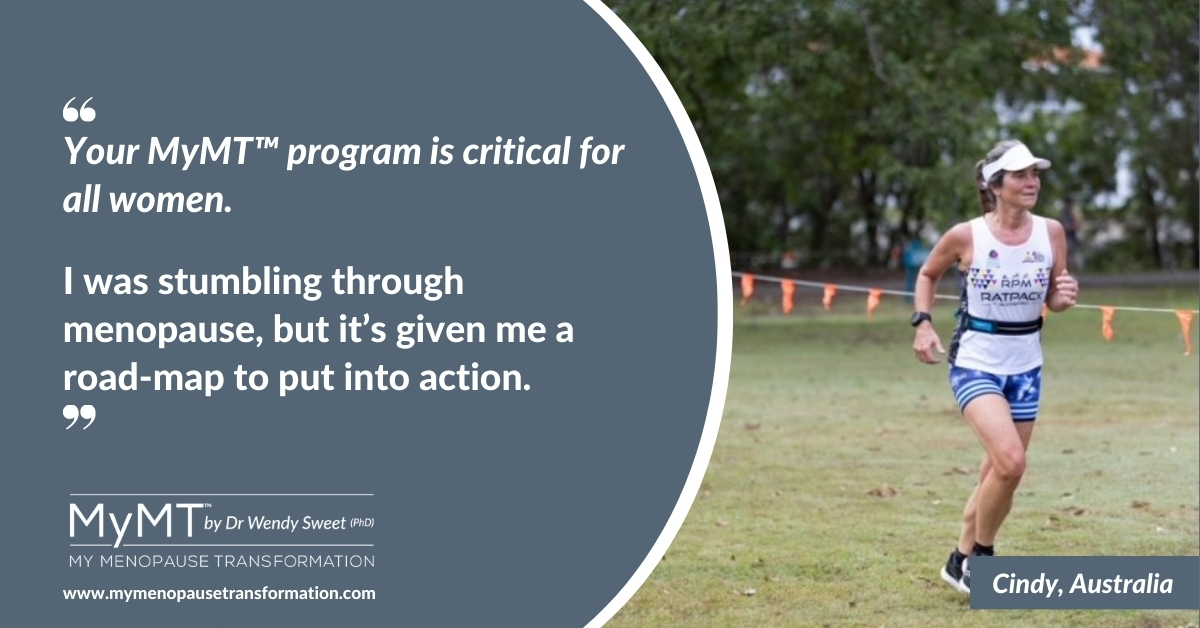
(3) Be cautious about heavy resistance training if you have varicose veins and high blood pressure and you aren’t sleeping well. All of these factors impact your blood pressure. I’ve noticed in the fitness industry here in New Zealand, that there is a move to encourage women in menopause to do heavy resistance weights to help prevent osteoporosis. However, this type of training isn’t ideal for everyone, especially those of you with varicose veins or spider veins and hypertension – or if you aren’t sleeping.
For years, I supervised Exercise Physiology laboratories for students. I know that blood pressure changes during heavy weight lifting. This was one of the laboratory sessions that I had students routinely do. It helped me emphasise the need for adequate blood pressure screening in those participating in exercise.
Studies from the prestigious Cooper Aerobic Institute in America, also report that the more muscle mass used during a resistance training exercise, the greater the blood pressure response. Hence, performing exercises which utilise both legs and arms in the same movement, such as a ‘clean and press’ or heavy squat, may increase blood pressure in midlife women, more so than single leg/arm exercises, such as a bicep curl.
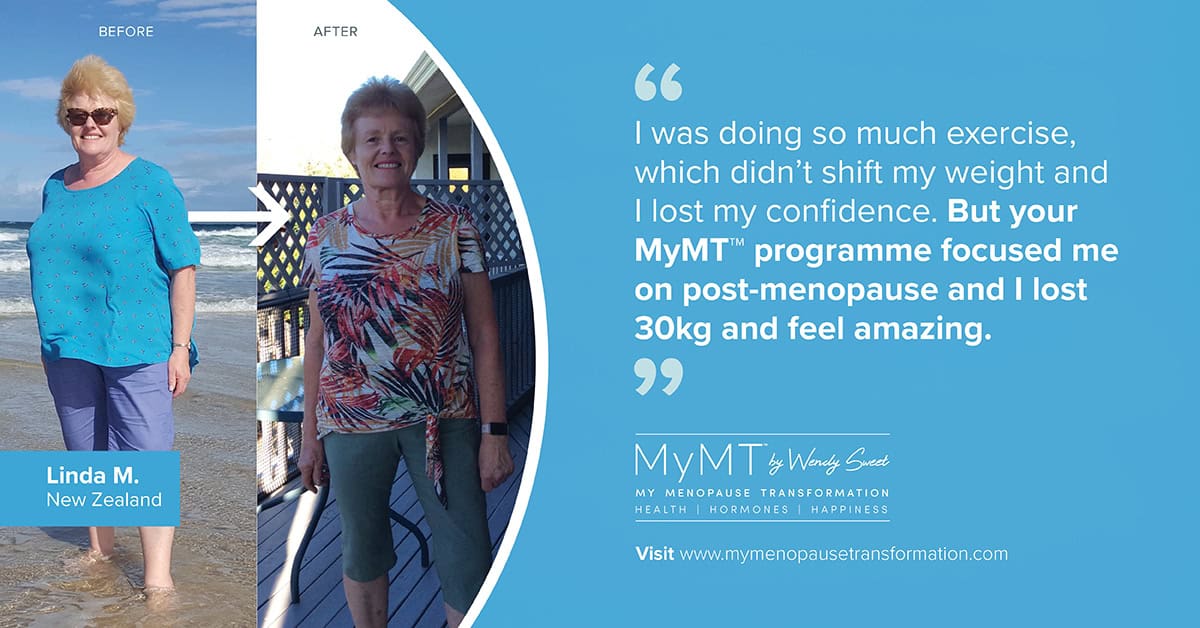
If you’re a middle aged woman and haven’t had your Blood Pressure checked and you are starting an exercise programme, then be aware that the more weight you lift, the greater the blood pressure response. Avoid maximal or near maximal lifts if you can until you are well trained by a registered Exercise Instructor.
An initial resistance of 30-40% of 1 RM (repetition max) which is the total amount of weight you can lift in one movement) for upper body and 50-60% of 1 RM for lower body exercises is an appropriate place to start.
As women go into their menopause transition, their risk for not exercising is as high as it’s ever been. This is because there hasn’t been a lot of understanding about how to look after ourselves during this life stage.
Staying active is a fundamental part of our healthy ageing and with the right information, women can remain active as they age. This includes doing the right exercise to support our ageing blood vessels.
The decline in oestrogen over the menopause transition, causes constriction of blood vessels and loss of elasticity, so this further increases the risk of high blood pressure and worsening varicose veins. This may also limit the flow of oxygen-rich blood to your organs and other parts of your body.
If your blood pressure has increased now that you are in your menopause or postmenopause years then yes, losing any excess weight helps, as does changing your diet and of course, watching the type of exercise that you do. Also important, is the need to improve your sleep quality and reduce your stress levels, both of which also cause an increase in blood pressure.
If we get this right during our menopause transition, then it will help to set us up to be able to enjoy a healthier future. I so want you to be able to achieve this.
Dr Wendy Sweet (PhD)/ My Menopause Transformation
P.S. If you haven’t listened to my Masterclass on Menopause yet, then have a listen to the video below when you can, as I explain what’s in it. I cover a raft of menopausal symptoms, including those you probably didn’t even know were symptoms! Menopause support is just a click away.
References:
Ciardullo, A., Panico, S., Bellati, C. et al. (2000). High endogenous estradiol is associated with increased venous distensibility and clinical evidence of varicose veins in menopausal women, Journal of Vascular Surgery, 32(3), 544-549.
Jani B, Rajkumar C. (2006). Ageing and vascular ageing. Postgrad Med J. 82(968):357-62. doi: 10.1136/pgmj.2005.036053.
Nascimento, D., da Silva, C. R., Valduga, R., Saraiva, B., de Sousa Neto, I. V., Vieira, A., Funghetto, S. S., Silva, A. O., Oliveira, S., Pereira, G. B., Willardson, J. M., & Prestes, J. (2018). Blood pressure response to resistance training in hypertensive and normotensive older women. Clinical interventions in aging, 13, 541–553.
Porth C., Bamrah V., Tristani F., Smith J. (1984). The Valsalva Maneuver: Mechanisms and clinical implications. Heart Lung. Sep;13(5):507-18.
